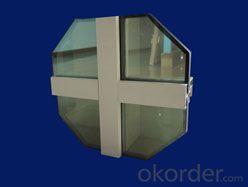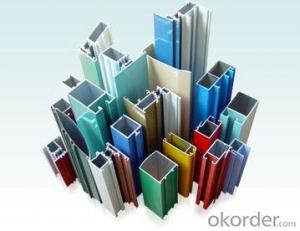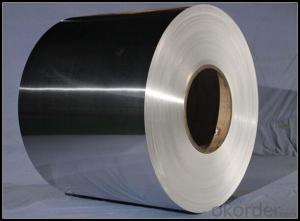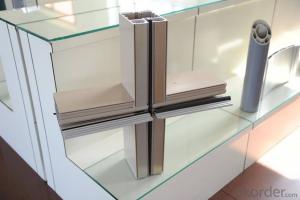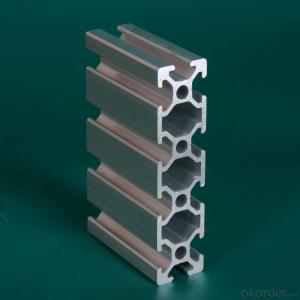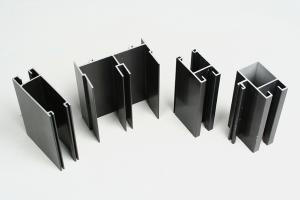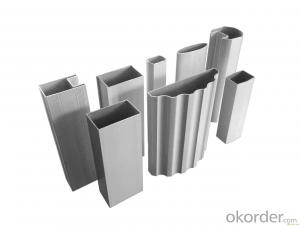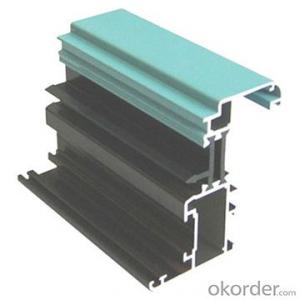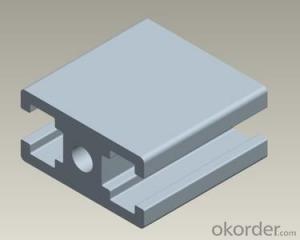Aluminum Extrusion U Channel Profiles for Aluminium Curtain Wall
- Loading Port:
- China Main Port
- Payment Terms:
- TT OR LC
- Min Order Qty:
- -
- Supply Capability:
- -
OKorder Service Pledge
OKorder Financial Service
You Might Also Like
ALUMINIUM CURTAIN WALL
Industrial aluminium profile
1)Material : 6063 6061 6060 and different aluminium alloy
2)Status:T4 T5 T6 or other special status
3)Surface treatment: mill finish, anodized sliver ,anodized bronze, anodized champagne, anodized black pearl, various power coating color, electrostatic sliver, electrostatic champagne, electrostatic golden, electrostatic titanium , machine polish sliver, machine polish bronze, wooden grain color, and Fluorocarbon spraying.
4)Annual capacity : 120000TON
5)Quality : China Nation Standard GB/T 5237 2008 (advanced class)
6)Use: can be widely using aluminium window, door, curtain wall, hand railing , normal aluminium profile, decorative and industrial aluminium profile
7)Advantage: Famous Brand reasonable&market price, soonest delivery and good after sale- service
8)Type of package:protection foam+heat contracted plastic film. / wooden packing / Metal pallet or depand on clientspecial requirement.
9)Payment term:T/T:30% of total value as deposite should paid by T/T within 3 days when confirmation ,and the remaining sum should be paid by T/T before delivery.L/C: 100% at sight
10)Delivery Day: 15-30days
11)Honor : CHINA FAMOUS TRADEMARK, CHINA TOP BRAND, ISO9001-2000, CHINA SQUARE&ROUND COMMITTEE DNV
- Q: This question asks about the impact of aluminum profiles on a building's ability to withstand fire.
- <p>Aluminum profiles can affect the fire resistance of a building in several ways. While aluminum itself has a high melting point and doesn't burn, it does conduct heat, which can lead to rapid temperature increases in the structure. To mitigate this, aluminum profiles used in construction are often coated with fire-resistant materials or combined with non-combustible materials. Additionally, the design of the building and the use of fire barriers can help to slow the spread of fire and heat. It's crucial to follow building codes and standards that specify the appropriate use of aluminum in fire-resistant construction to ensure the safety and integrity of the structure during a fire.</p>
- Q: How do aluminum profiles perform in seismic or earthquake-prone areas?
- Aluminum profiles have shown to perform well in seismic or earthquake-prone areas due to their inherent properties. Aluminum is a lightweight and flexible material, which allows it to absorb and dissipate seismic energy effectively. This helps in reducing the impact of earthquakes on structures and minimizing damage. Additionally, aluminum profiles are highly resistant to corrosion, which is beneficial in areas with high seismic activity as it ensures the longevity and structural integrity of buildings.
- Q: Is it feasible to recycle aluminum profiles economically and in significant quantities?
- <p>Yes, aluminum profiles can be recycled at a reasonable cost and volume. Recycling aluminum is more cost-effective than mining and refining new aluminum from bauxite. The process requires less energy, which reduces costs. Additionally, aluminum has a high recycling rate, with about 75% of all aluminum ever produced still in use today. This indicates that aluminum recycling is both economically viable and can be done in significant volumes, contributing to sustainability and waste reduction.</p>
- Q: in addition to the groove width is not the same as other well differentiated? Is there any difference in wall thickness?
- There must be a difference. There is a distinction between rice weight and wall thickness. For example, Jing Teng Aluminum CompanyJT-8-5050W meters weight is 3.25KG,,JT-10-5050 meters weight is 2.95KG. Specific parameters, you can go to consult the next business
- Q: This question asks if it is possible to recycle aluminum profiles in a simple and effective manner.
- <p>Yes, aluminum profiles can be recycled easily and efficiently. Aluminum is one of the most recycled materials in the world due to its non-toxic nature and the energy efficiency of the recycling process. Recycling aluminum requires only 5% of the energy needed to produce new aluminum from raw materials. Additionally, aluminum can be recycled indefinitely without losing its properties, making it a highly sustainable material. The recycling process involves melting the aluminum, which is a relatively simple and cost-effective procedure compared to many other materials. This makes aluminum an ideal material for sustainable manufacturing and waste reduction strategies.</p>
- Q: Are aluminum profiles suitable for conveyor rollers?
- Conveyor rollers can benefit from the use of aluminum profiles. Aluminum, known for its lightweight and durability, offers several advantages for conveyor systems. Firstly, the strength-to-weight ratio of aluminum profiles is outstanding, making them an ideal choice for conveyor rollers. They possess enough strength to handle the weight of transported materials while being light enough to reduce the overall weight of the conveyor system. This results in energy savings and easier installation and maintenance. Additionally, aluminum profiles exhibit excellent resistance to corrosion, which is crucial for conveyor systems operating in harsh environments, such as those exposed to moisture or chemicals. This corrosion resistance ensures the longevity and reliability of the conveyor rollers, reducing the need for maintenance and associated costs. Furthermore, aluminum profiles can be easily customized and fabricated to meet specific requirements of the conveyor system. They can be extruded into various shapes and sizes, allowing for the creation of conveyor rollers that perfectly match the application's needs. This versatility makes aluminum profiles adaptable and suitable for a wide range of conveyor systems in industries like manufacturing, packaging, and logistics. Moreover, aluminum is highly sustainable as it can be 100% recycled, making it an environmentally friendly choice for conveyor rollers. By utilizing aluminum profiles, companies can contribute to their sustainability goals and decrease their carbon footprint. In conclusion, aluminum profiles are indeed a suitable option for conveyor rollers because of their lightweight, durable, corrosion-resistant, customizable, and sustainable characteristics.
- Q: Are aluminum profiles suitable for use in exterior wall insulation systems?
- <p>Yes, aluminum profiles can be used for exterior wall insulation systems. They are known for their durability, resistance to corrosion, and ability to withstand various weather conditions. Aluminum profiles provide a strong structural framework that can support insulation materials effectively. They are also lightweight, which makes them easy to handle and install. Additionally, aluminum profiles can be anodized or coated to enhance their resistance to environmental factors, making them a popular choice for exterior insulation systems.</p>
- Q: Can aluminum profiles be used in material handling equipment manufacturing?
- Yes, aluminum profiles can be used in material handling equipment manufacturing. Aluminum profiles are lightweight, durable, and have excellent strength-to-weight ratio, making them suitable for constructing various components such as frames, supports, and conveyors in material handling equipment. Additionally, aluminum profiles offer versatility in terms of customization and can be easily assembled, making them a popular choice in this industry.
- Q: How do aluminum profiles perform in electrical insulation applications?
- Aluminum profiles generally do not perform well in electrical insulation applications. Unlike materials such as plastic or rubber, aluminum is a conductor of electricity and does not possess the insulating properties required to prevent the flow of electric current. Therefore, using aluminum profiles in electrical insulation applications can pose significant risks, such as the risk of electric shock or short circuits. It is essential to choose materials specifically designed for electrical insulation purposes, such as insulating plastics or rubber, to ensure the safety and effectiveness of electrical systems.
- Q: Can aluminum profiles be used for signage?
- Yes, aluminum profiles can be used for signage. Aluminum is a versatile and durable material that is commonly used in the signage industry. Its lightweight nature, corrosion resistance, and flexibility make it an ideal choice for outdoor and indoor signage applications. Additionally, aluminum profiles can be easily customized and fabricated to create various shapes and sizes of signage.
Send your message to us
Aluminum Extrusion U Channel Profiles for Aluminium Curtain Wall
- Loading Port:
- China Main Port
- Payment Terms:
- TT OR LC
- Min Order Qty:
- -
- Supply Capability:
- -
OKorder Service Pledge
OKorder Financial Service
Similar products
Hot products
Hot Searches
Related keywords



